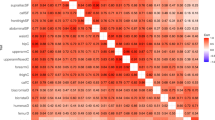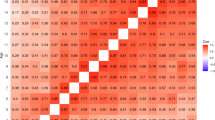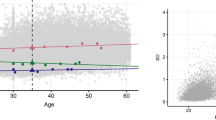Abstract
OBJECTIVE: Although many twin and adoption studies document genetic influence on individual differences in weight, much less is known about genetic influences on overweight, about the genetic links between weight and overweight, or about the origins of weight and overweight in childhood, an age that might provide a good target for prevention of obesity. We tested the hypothesis that, in early childhood, overweight is as heritable as weight and that weight and overweight are linked genetically.
DESIGN: Model-fitting analyses were used to compare monozygotic (MZ) and dizygotic (DZ) twins (same-sex and opposite-sex) for weight and overweight.
SUBJECTS: The sample included 3636 4-y-old twins born in the UK in 1994.
MEASUREMENTS: Heights and weights reported by parents were used to assess weight corrected for height, which yields results similar to body mass index (BMI) but corrects more completely for genetic effects on height.
RESULTS: At 4 y of age, genetic factors contributed substantially both to individual differences in weight throughout the distribution and to the mean weight difference between overweight children and the rest of the population. Unlike results later in life, weight and overweight in 4-y-olds also suggest substantial shared family environmental influence. Results are similar for boys and girls.
CONCLUSIONS: Overweight is the quantitative extreme of genetic and environmental factors responsible for normal variation in weight in childhood. Genes associated with overweight are likely to be associated with variation in weight throughout the distribution, as assumed by quantitative trait locus (QTL) theory. These findings linking weight and overweight in childhood have far-reaching implications for molecular genetic attempts to identify specific genes responsible for genetic influence, for investigating pathways between genes and behaviour, and for intervention and prevention.
This is a preview of subscription content, access via your institution
Access options
Subscribe to this journal
Receive 12 print issues and online access
$259.00 per year
only $21.58 per issue
Buy this article
- Purchase on Springer Link
- Instant access to full article PDF
Prices may be subject to local taxes which are calculated during checkout




Similar content being viewed by others

References
Maes HH, Neale MC, Eaves LJ . Genetic and environmental factors in relative body weight and human adiposity Behav Genet 1997 27: 325–351.
Grilo CM, Pogue-Geile MF . The nature of environmental influences on weight and obesity: a behavior genetic analysis Psycholo Bull 1991 110: 520–537.
Medlund P, Cederlöf R, Floderus-Myrhed B, Friberg L, Sörensen S . A new Swedish twin registry containing environmental and medical base line data from about 14,000 same-sexed pairs born 1926-58 Acta Med Scand 1976 60: 1–111.
Plomin R . Genetic research on general cognitive ability as a model for mild mental retardation Int Rev Psychiat 1999 11: 34–46.
Børjeson M . The aetiology of obesity in children: a study of 101 twin pairs Acta Paediatr Scand 1976 65: 279–287.
DeFries JC, Fulker DW . Multiple regression analysis of twin data Behav Genet 1985 15: 467–473.
DeFries JC, Fulker DW . Multiple regression analysis of twin data: etiology of deviant scores versus individual differences Acta Genet Med Gemellol (Roma) 1988 37: 205–216.
Dietz WH . Critical periods in childhood for the development of obesity Am J Clin Nutr 1994 59: 829–840.
Kotani K, Nishida M, Yamashita S, Funahashi T, Fujioka S, Tokunaga K, Ishikawa K, Tarui S, Matsuzawa Y . Two decades of annual medical examinations in Japanese obese children: do obese children grow into obese adults? Int J Obes Relat Metab Disord 1997 21: 912–921.
Must A, Strauss RS . Risks and consequences of childhood and adolescent obesity Int J Obes Relat Metab Disord 1999 23 (Suppl 2): S2–S11.
Dale PS, Simonoff E, Bishop DV, Eley TC, Oliver B, Price TS, Purcell S, Stevenson J, Plomin R . Genetic influence on language delay in two-year-old children Nature Neurosci 1998 1: 324–328.
Price TS, Freeman B, Craig I, Petrill SA, Ebersole L, Plomin R . Infant zygosity can be assigned by parental report questionnaire data Twin Res 2000 3: 129–133.
Plomin R, DeFries J, McClearn G, McGuffin P . Behavioral genetics. 4th edn. Worth Publishers: New York 2001.
Neale MC, Cardon LR . Methodology for genetic studies of twins and families Kluwer Academic: Dordrecht 1992.
Plomin R . Development, genetics, and psychology Lawrence Erlbaum: Hillsdale, NJ 1986.
Neale MC . Mx: Statistical Modeling Department of Psychiatry: Richmond, VA 1997.
Barsh GS, Farooqi IS, O'Rahilly S . Genetics of body-weight regulation Nature 2000 404: 644–651.
Kopelman, PG . Obesity as a medical problem Nature 2000 404: 635–643.
Harris JR, Tambs K, Magnus P . Sex-specific effects for body mass index in the new Norwegian twin panel Genet Epidemiol 1995 12: 251–265.
Herskind AM, McGue M, Sorensen TI, Harvald B . Sex and age specific assessment of genetic and environmental influences on body mass index in twins Int J Obes Relat Metab Disord 1996 120: 106–113.
Pietilainen KH, Kaprio J, Rissanen A, Winger T, Rimpela A, Viken RJ . Distribution and heritability of BMI in Finnish adolescents age 16 and 17 y: a study of 4884 twins and 2509 singletons Int J Obes Relat Metab Disord 1999 23: 107–115.
Phillips DIW . Twin studies in medical research: can they tell us whether diseases are genetically determined? Lancet 1993 341: 1008–1009.
Christensen K, Vaupel JW, Holm NV, Yashlin AI . Mortality among twins after age 6: fetal origins hypothesis versus twin method Br Med J 1995 310: 432–436.
Reed DR, Price RA . Estimates of the heights and weights of family members: accuracy of informant reports Int J Obes Relat Metab Disord 1998 22: 827–835.
Faith MS, Pietrobelli A, Nunez C, Heo M, Heymsfield SB, Allison DB . Evidence for independent genetic influences on fat mass and body mass index in a pediatric twin sample Pediatrics 1999 104: 61–67.
Cardon LR, Carmelli D, Fabsitz RR, Reed T . Genetic and environmental correlations between obesity and body fat distribution in adult male twins Hum Biol 1994 66: 465–479.
Kromeyer-Hauschild K, Zellner K, Jaeger U, Hoyer H . Prevalence of overweight and obesity among school children in Germany Int J Obes Relat Metab Disord 1999 23: 1143–1150.
Prescott-Clarke P, Primatesta P (eds) . Health Survey for England 1996: a survey carried out on behalf of the Department of Health HMSO: London 1998.
World Health Organization MONICA Project . Geographical variation in the major risk factors of coronary heart disease in men and women aged 35–64 y Wld Health Stat Q 1988 41: 115–140.
Reilly JJ, Savage SA, Ruxton CH, Kirk TR . Assessment of obesity in a community sample of prepubertal children Int J Obes Relat Metab Disord 1999 23: 217–219.
Acknowledgements
We thank the parents of the twins in the Twins Early Development Study (TEDS) for making the study possible. TEDS is supported by a programme grant from the UK Medical Research Council. Investigations of eating and weight in the TEDS sample are supported by a grant from the BBSRC.
Author information
Authors and Affiliations
Corresponding author
Rights and permissions
About this article
Cite this article
Koeppen-Schomerus, G., Wardle, J. & Plomin, R. A genetic analysis of weight and overweight in 4-year-old twin pairs. Int J Obes 25, 838–844 (2001). https://doi.org/10.1038/sj.ijo.0801589
Received:
Revised:
Accepted:
Published:
Issue Date:
DOI: https://doi.org/10.1038/sj.ijo.0801589
Keywords
This article is cited by
-
Genetics and Epigenetics in Obesity: What Do We Know so Far?
Current Obesity Reports (2023)
-
A twin study of self-regulatory eating in early childhood: estimates of genetic and environmental influence, and measurement considerations
International Journal of Obesity (2012)
-
History matters: childhood weight trajectories as a basis for planning community-based obesity prevention to adolescents
International Journal of Obesity (2012)
-
Genetic and Environmental Influences on BMI From Late Childhood to Adolescence are Modified by Parental Education
Obesity (2012)
-
Heritability of body mass index in pre-adolescence, young adulthood and late adulthood
European Journal of Epidemiology (2012)


